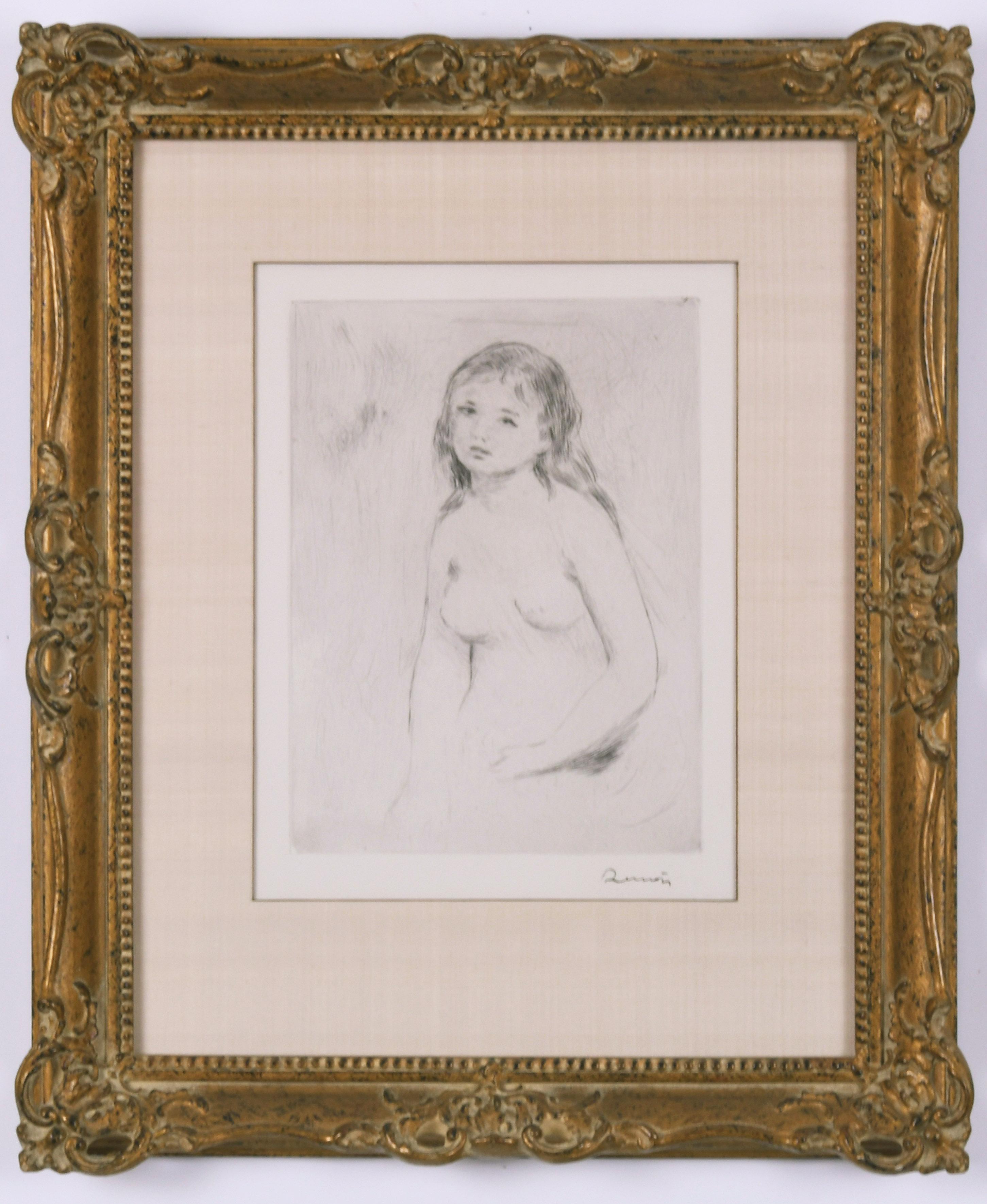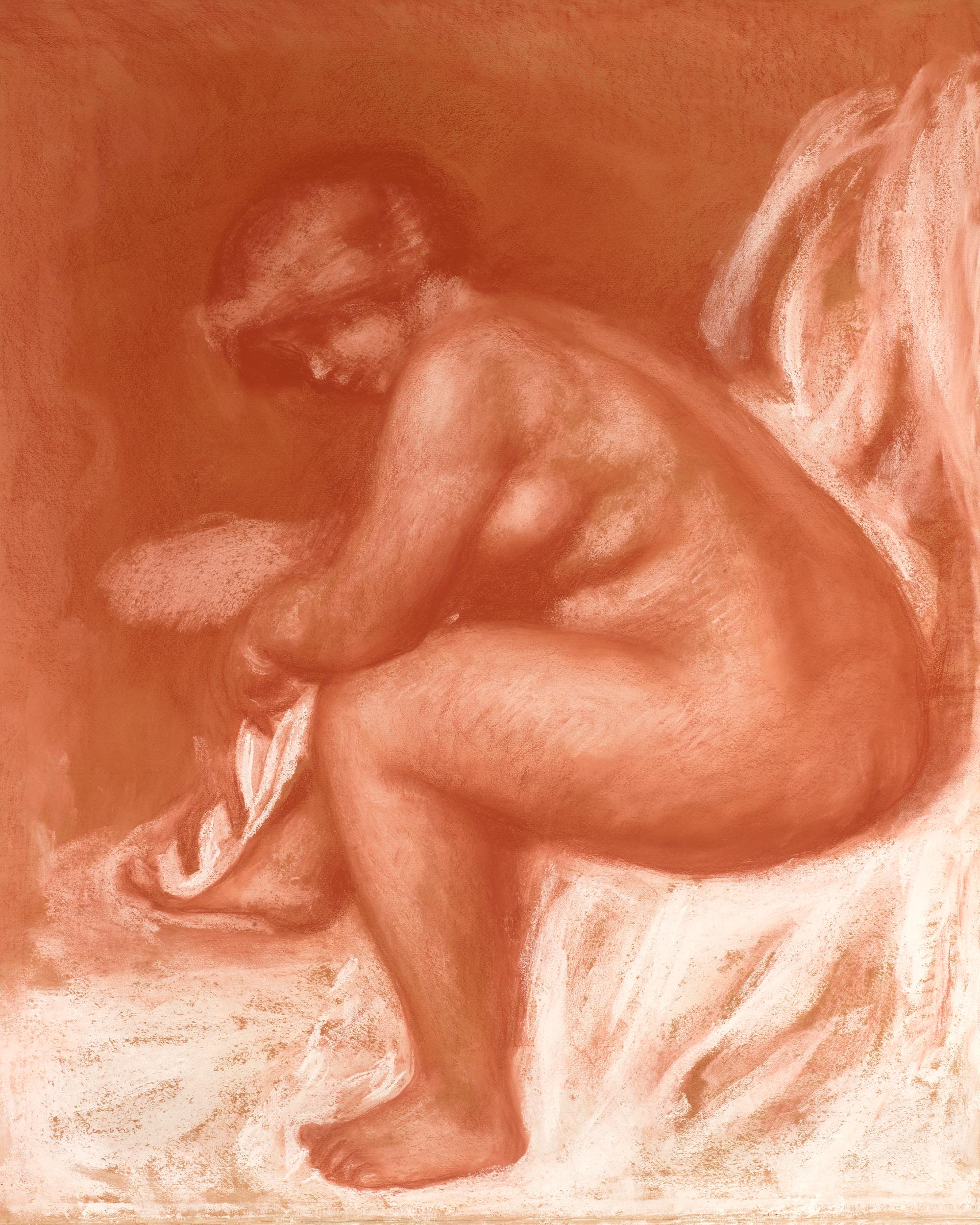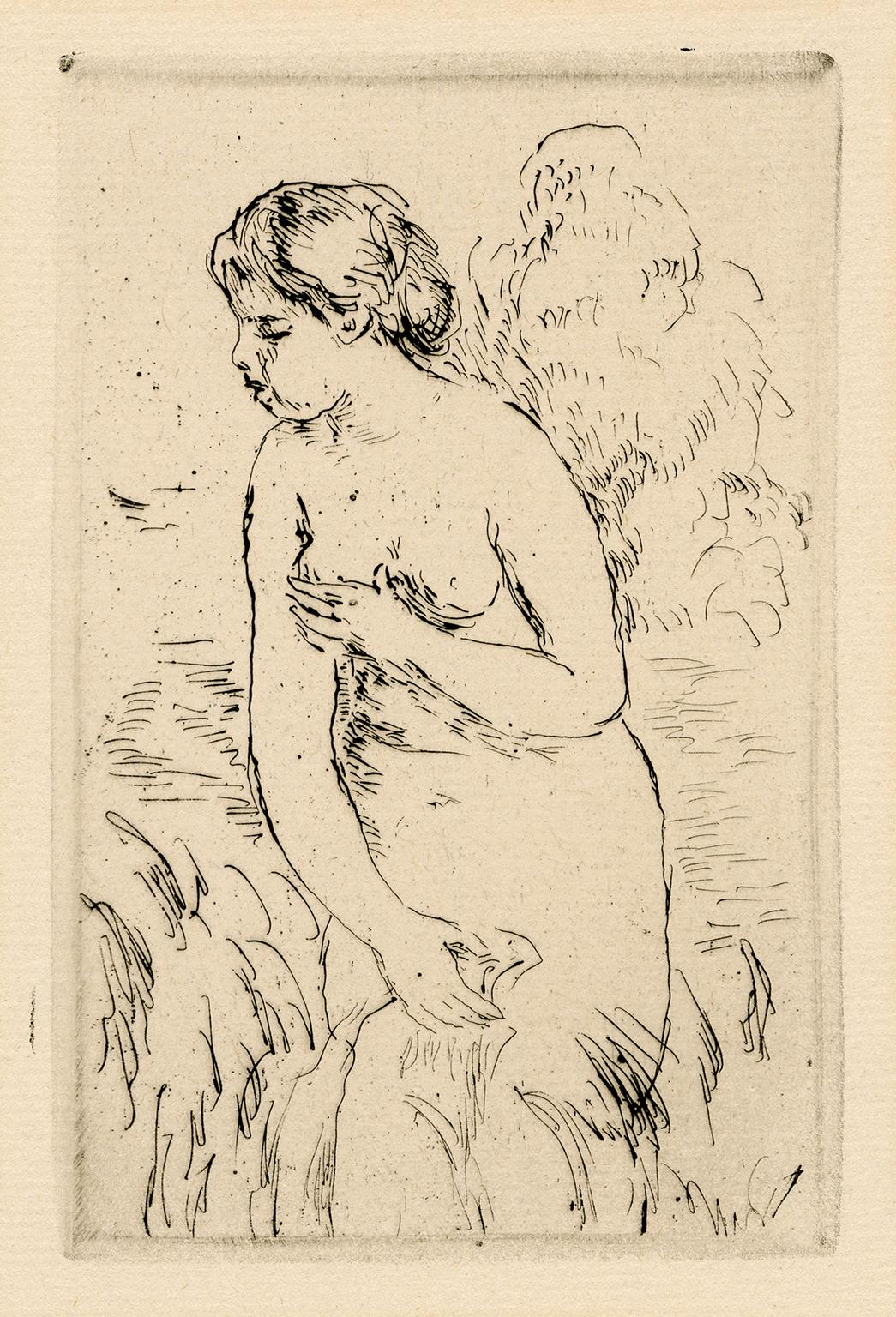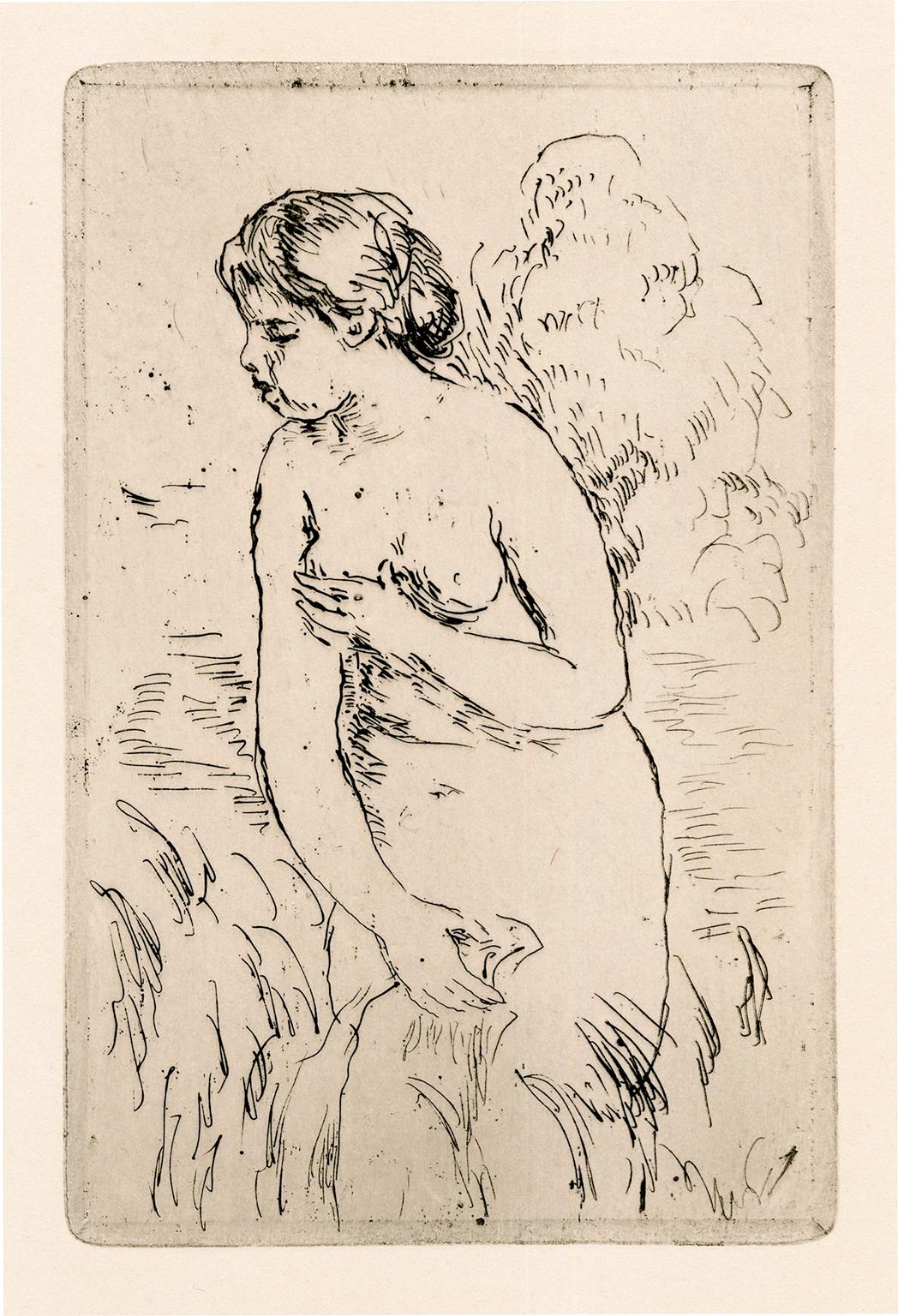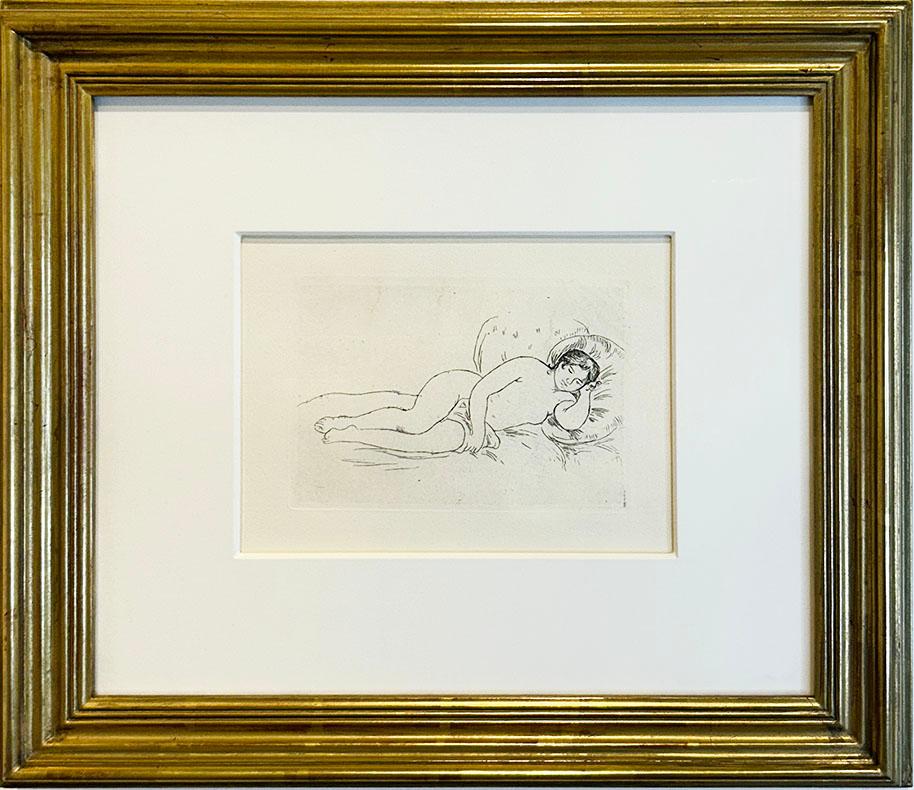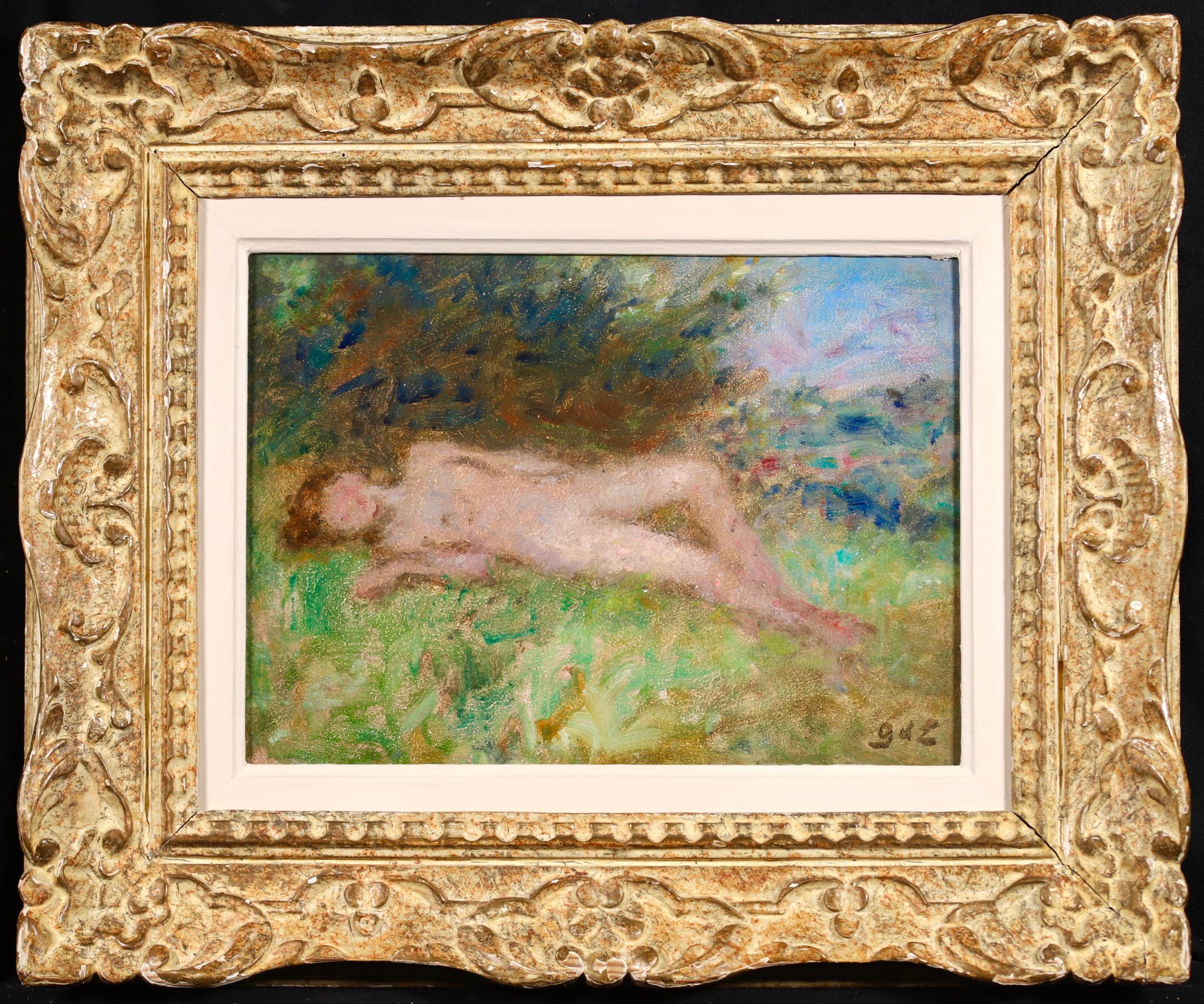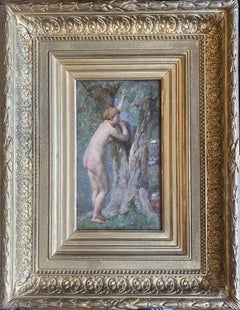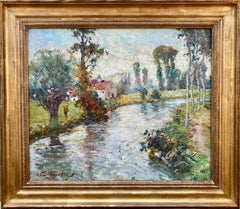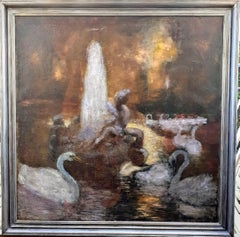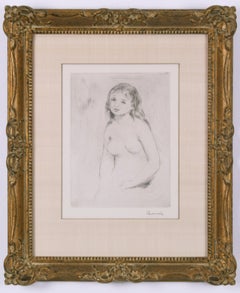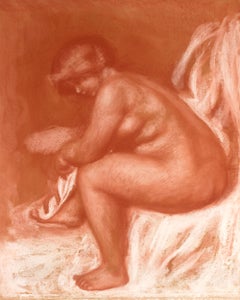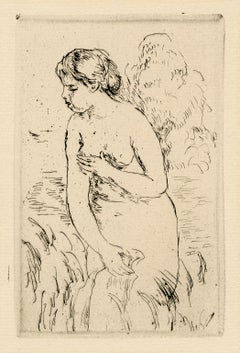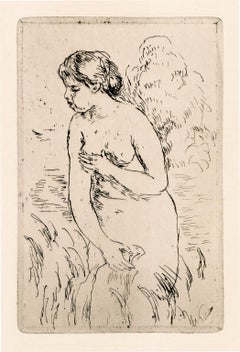Items Similar to Auguste Renoir"s last student: impressionist female nude the Statuesque Bather
Want more images or videos?
Request additional images or videos from the seller
1 of 9
Lucien BoulierAuguste Renoir"s last student: impressionist female nude the Statuesque Bathercirca 1910
circa 1910
$740
£562.74
€649.09
CA$1,036.60
A$1,160.17
CHF 605.79
MX$14,154.09
NOK 7,689.68
SEK 7,297.03
DKK 4,847.10
Shipping
Retrieving quote...The 1stDibs Promise:
Authenticity Guarantee,
Money-Back Guarantee,
24-Hour Cancellation
About the Item
If something about this painting seems familiar, it is for good reason! Dating from circa 1905-10, it is a work by Lucien Boulier (1882-1963), who was effectively Renoir's last student. Perhaps the Master even helped a little?
Boulier had studied at the Ecole des Beaux-Arts in Paris, where he won a first prize medal before withdrawing to study on his own at the Louvre. He was particularly attracted to the work of the Impressionists, especially the work of Pierre-Auguste Renoir, with whom he went on to study privately. Boulier's work was shown in a number of exhibitions during the 1920s, most notably at Galerie Charpentier in Paris in 1923; and at Wildenstein Gallery in New York in 1924.The delightful statuesque bather presented here is an oil on canvas relined measuring 22 x 27 cm. It bears the Lucien Boulier estate sale stamp at the lower right, and hence comes directly from the artist's studio. Boulier's studio was dispersed in 1963.
The overall size including an attractive frame is 35 x 40 cm.
- Creator:Lucien Boulier (1882-1963, French)
- Creation Year:circa 1910
- Dimensions:Height: 13.78 in (35 cm)Width: 15.75 in (40 cm)Depth: 1.19 in (3 cm)
- Medium:
- Movement & Style:
- Period:
- Condition:Canvas relined, light wear.
- Gallery Location:Norwich, GB
- Reference Number:1stDibs: LU991314821512
About the Seller
5.0
Gold Seller
Premium sellers maintaining a 4.3+ rating and 24-hour response times
1stDibs seller since 2018
90 sales on 1stDibs
Typical response time: 1 hour
- ShippingRetrieving quote...Shipping from: Norwich, United Kingdom
- Return Policy
Authenticity Guarantee
In the unlikely event there’s an issue with an item’s authenticity, contact us within 1 year for a full refund. DetailsMoney-Back Guarantee
If your item is not as described, is damaged in transit, or does not arrive, contact us within 7 days for a full refund. Details24-Hour Cancellation
You have a 24-hour grace period in which to reconsider your purchase, with no questions asked.Vetted Professional Sellers
Our world-class sellers must adhere to strict standards for service and quality, maintaining the integrity of our listings.Price-Match Guarantee
If you find that a seller listed the same item for a lower price elsewhere, we’ll match it.Trusted Global Delivery
Our best-in-class carrier network provides specialized shipping options worldwide, including custom delivery.More From This Seller
View AllThe bather and the artist: the bashful nude naturalist French oil painting
Located in Norwich, GB
It's just a little embarassing. Our young bather went for a skinny dip in the river and now needs to snatch her clothes without being spotted by the elderly artist on the river bank ...
Category
1880s Academic Nude Paintings
Materials
Oil, Wood Panel
Barbizon Fontainebleau region Impressionist French summer landscape with figure
Located in Norwich, GB
A wonderful view of the heartbreakingly beautiful Fontainebleau/Barbizon region, which was home to some of the greatest painters of the 19th and early 20th Century. The particular spot presented here is the river Loing at Montigny-sur-Loing, where Cezanne and Sisley loved to paint. The village is just a short walk away from Grez-sur-Loing, where John Singer Sargent, Francis Brooks Chadwick, Robert Vonnoh, Edward Simmons...
Category
Early 1900s Impressionist Landscape Paintings
Materials
Canvas, Oil
Swan Lake: large art deco period French post impressionist landscape painting
By Marius Petit
Located in Norwich, GB
A stunning and atmospheric painting by Marius Petit (1882-1960). It dates from the 1920s, the height of the art deco period. Glorious, scintillating and beautifully coloured; it is a...
Category
Early 20th Century French School Figurative Paintings
Materials
Canvas, Oil
Children on the Beach Marine Landscape French Antique Oil Painting
Located in Norwich, GB
The setting is the French coast, on a tranquil summer's evening. Clouds are drawing in, the sky is turning dusky pink and purple, but there is still time left for play, for the children on the beach...
Category
Early 20th Century Academic Landscape Paintings
Materials
Canvas, Oil
The first time model: the enigmatic young bohemian girl in traditional dress
Located in Norwich, GB
I love the feisty attitude of the girl depicted! With her hand on her hip, she seems to be saying to the artist: "Whatya looking at anyway?" She looks like she has a good head on he...
Category
Late 19th Century Academic Portrait Paintings
Materials
Canvas, Oil
Italian Art nouveau Nude Boudoir painting woman warming herself by a stove Paris
By Tito Lessi
Located in Norwich, GB
A very pure and tender rendition of a female nude. Elegant in its simplicity, the artist's model, is warming herself by a large stove!
It is a work by Tito Lessi dating from circa 1890. Lessi was born in Florence, Italy and studied at the Florentine Academy of Fine Arts, under Enrico Pollastrini and Antonio Ciseri...
Category
1890s Academic Nude Drawings and Watercolors
Materials
Watercolor, Laid Paper
You May Also Like
Etude pour une baigneuse (Study for a Bather)
By Pierre Auguste Renoir
Located in Fairlawn, OH
Etude pour une baigneuse (Study for a Bather)
Drypoint, 1901-1911
Signed with the signature stamp, Lugt 2137a
Printed: Louis Fort, Paris
Publisher: Ambrose Vollard, Paris
"The fame o...
Category
Early 1900s Impressionist Nude Prints
Materials
Drypoint
Après le bain (After the bath)
By Pierre Auguste Renoir
Located in New Orleans, LA
For Pierre-Auguste Renoir, Impressionism's pre-eminent figure painter, depicting the nude was an exercise in bringing the canvas to life. He once said, “I look at a nude, I see myriads of minuscule shades. I have to find those which will make the flesh on my canvas come to life and resonate.” This compelling portrait by Renoir entitled Après le bain presents the nude figure of a woman in a serene, private moment, absorbed in the task of drying herself after a bath. The artist’s mastery of light and shading is incredible, achieving a sense of vitality in this otherwise ordinary scene.
Renoir is celebrated for his figural work, especially his Rubenesque female nudes, however, it was not until the artist was in his forties that he depicted the nude with any frequency. In 1881, Renoir traveled to Italy, where he studied the works of the Renaissance masters and the ancient art of Pompeii and Rome. Upon his return to France, the nude became his favored subject, and he used the motif to combine the spontaneity of Impressionism with the solid modeling of classical painting. Renoir’s medium here, sanguine, a reddish-brown chalk, was used extensively in the Renaissance by Leonardo (who employed it in his sketches for the Last Supper), Michelangelo and Raphael. Its warm hue lends itself well to depicting flesh, and the chalk drawing allows for a greater focus on line, form and texture in a departure from the aspects of color and light that so often preoccupied the Impressionists. Après le bain conveys the impression of arrested motion with perfect naturalness, deftly capturing the moment before the elegant lines of the sitter's form change position.
The sitter is almost certainly Gabrielle Renard, the nanny to Renoir’s children and a frequent model for the artist. Gabrielle was the cousin of Renoir’s wife, Aline, and came to Montmartre to work for the family at the age of 16. She developed a strong bond with the family and became a favorite subject for Renoir, appearing in several of his most important works, including his 1911 Gabrielle with a Rose (Musée d'Orsay). When Renoir began to suffer from severe rheumatoid arthritis that would eventually leave him unable to walk and scarcely able to grasp a paintbrush, it was Gabrielle that would assist the artist by positioning the paintbrush between his crippled fingers.
Born in Limoges, France in 1841, Renoir began his career as an apprentice to a painter of porcelain wares. He later moved to Paris at the age of 21, enrolling at the prestigious École des Beaux-Arts. It was here, while studying under Charles Gleyre, that Renoir attained a tremendous appreciation for the academic style of painting, a quality that would last throughout his career. This was also when he met Claude Monet and several other classmates, with whom he would later form the Impressionists.
Working closely with Monet, Renoir began experimenting with the portrayal of light and its effect on his canvases. The youngest member of the Impressionist movement, an astute Renoir recognized how a subject was constantly changing due to the dynamic effects of light on color. Relying heavily upon his academic training that focused on composition, lines and descriptive details, Renoir distinguished himself among his contemporaries. His intuitive use of color and expansive brushstroke, along with acute attention to his subject, have placed him among the finest painters in history.
This work is accompanied by a certificate of authenticity and will be included in the forthcoming catalogue raisonné of the work of Pierre-Auguste Renoir from the Wildenstein Plattner Institute.
Circa 1898
Canvas: 43 1/2" high x 35 1/2" wide
Frame: 57 3/4" high x 49 1/4" wide
Provenance:
Galerie Durand-Ruel, Paris (acquired from the artist on January 25, 1899)
J. Pereire Collection, France (1966)
Sam Salz, New York (before 1981)
Claus Virch, Paris
French Compagny, Inc., New York
Larry Silverstein, New York (circa January 1987)
Le Clos de Sierne Gallery, Geneva
Galerie Heyram, Paris (October 1987)
Francis Gross
M.S. Rau, New Orleans
Literature:
B. Schneider, Renoir, Berlin, 1957, p. 95 (illustrated in color, p. 83)
M. Gauthier, Renoir, Paris, 1958, p. 83 (illustrated in color; erroneously dated '1916' and titled 'Woman in her toilet')
F. Fosca, Renoir, L'homme et son obra, Paris, 1961, p. 280 (illustrated, p. 95; erroneously dated 'about 1890' and titled 'After the Bath...
Category
19th Century Impressionist Nude Paintings
Materials
Canvas, Paper, Chalk
Price Upon Request
Baigneuse Debout, à Mi-Jambes — French Impressionism
By Pierre-Auguste Renoir
Located in Myrtle Beach, SC
Pierre Auguste Renoir, 'Baigneuse Debout, à Mi-Jambes (Woman Bathing, Standing Up to Her Knees in Water)', 1910, etching, edition not stated, Delteil 23. Unsigned as published. A fin...
Category
1910s Impressionist Nude Prints
Materials
Etching
'Baigneuse Debout, à Mi-Jambes' — French Impressionism
By Pierre-Auguste Renoir
Located in Myrtle Beach, SC
Pierre Auguste Renoir, 'Baigneuse Debout, à Mi-Jambes (Woman Bathing, Standing Up to Her Knees in Water)', 1910, etching, edition not stated, Delteil 23. Unsigned as published. A fin...
Category
1910s Impressionist Nude Prints
Materials
Etching
$600 Sale Price
20% Off
Renoir, Femme Nue Couchee
By Pierre-Auguste Renoir
Located in Boston, MA
Artist: Renoir, Auguste
Title: Femme Nue Couchee
Date: 1906
Medium: Softground Etching
Unframed Dimensions: 5.5" x 7.8"
Framed Dimensions: 18.25" x 20.75"
Signature: Unsigned
...
Category
Early 1900s Impressionist Prints and Multiples
Materials
Etching
Nu allonge - Post Impressionist Nude Figurative Oil - Georges D'Espagnat
By Georges d'Espagnat
Located in Marlow, Buckinghamshire
Signed oil on panel nude circa 1920 by French post impressionist painter Georges D'Espagnat. The work depicts a nude woman laying a patch of green grass on top of a hill with a view of the valley in the distance.
Signature:
Signed lower right
Dimensions:
Framed: 16"x20"
Unframed: 9"x13"
Provenance:
A certificate of authenticity for this work is available from Mr. Jean Dominique Jacquemond upon request
Private French collection
From the beginning of his career, it was a constant concern of Georges d'Espagnet to assert his originality. His studies at the École des Arts Décoratifs, Paris, did not last very long, for he wanted immediate independence and decided to follow courses in the private academies of Montparnasse. In about 1900, he became acquainted with Maurice Denis, Bonnard and Vuillard, and his collaboration with Denis led to a renewal of religious art in France.
In 1903, d'Espagnet was one of the founders of the Salon d'Automne, and was appointed professor in charge of studios at the École des Beaux-Arts, Paris, in 1934. He illustrated a number of books: Rémy de Gourmont's Evil Prayers ( Oraisons mauvaises) (1896), The Saints of Paradise ( Les Saintes du paradis) (1898), Simone (1907), Sistine ( Sixtine) (1922); Alphonse Daudet's The Immortal ( L'Immortel) (1930); André Gide's The Pastoral Symphony ( La Symphonie pastorale); Francis Jammes' Clearings in the Sky ( Chairières dans le ciel) (1948).
D'Espagnet belongs to the group of artists who made the Courrier Français so successful. The drawings of his which are published in it are strongly expressive and some bear comparison with the designs of the great Renaissance masters. He also contributed to L'Image. He often placed cheerful nudes in a landscape, reminding us that, though he moved away from the Fauves, he retained their freedom of colour and arabesque. He painted many portraits, including those of Albert André, André Barbier, Victor Boucher, Déodat de Séverac, Albert Marque, André Marty and Albert Roussel. He also painted mural decorations, including a wall for the Palais de la Découverte (1937), the ceiling of the Victor Hugo Room in the Palais du Luxembourg (1939), a decorative panel for the Palais de Justice, Toulouse (1941) and interior decorations for private houses. His landscapes are Impressionist in inspiration, and work for a certain sobriety, an intimacy, both in their composition - one, two or three sketched figures and large open spaces - and in the choice of colours and treatment with the special hazy brushstroke that marks his style.
D'Espagnet took part in a number of annual Parisian exhibitions, including the Salon des Indépendants, the Salon de la Société Nationale des Beaux-Arts, the Salon d'Automne (from 1903 to 1949, except in special circumstances), the Salon de la Libre Ésthétique, Brussels (1899, 1901), the Berlin Secessionists (1940). He also exhibited at the first Salon de la Société de la Gravure sur Bois. Among other exhibitions were 1912, A Century of French Art ( Centenaire de l'art français), St Petersburg; 1916, Kunstverein, Winterthur; 1918, 1926, Galerie M. Bertheim, Paris; 1930, Contemporary French Art...
Category
1920s Post-Impressionist Nude Paintings
Materials
Oil, Panel
More Ways To Browse
Impressionist Female Nude
Prize Antiques
Early 20th Century Nude Female Paintings
Nude Bather
Nude Bather Painting
Galerie Charpentier
The Louvre Antiques
Renoir Bather
Prado Museum
Semi Nude Painting
17th Century Painting Of Christ
Ferrari Car Art
Horse Sculptures From India
Native American Girl Painting
C Manuel
Circus Horse
Circus Horses
Crumpled Paper
